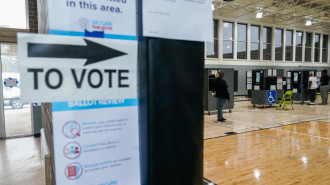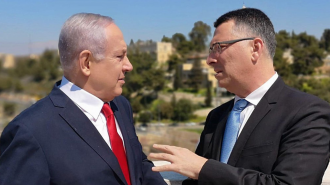Rights group documents 72 horrific torture methods used by Syrian regime in harrowing new report
The Syrian Network for Human Rights (SNHR) has documented 72 torture methods which the Syrian regime continues to practice in its detention centres and prisons in a new report released on Monday.
It called on the US Congress to pass the Caesar Act which would provide accountability and more protection to civilians, after identifying 801 individuals who appeared in the photographs smuggled out by the former regime photographer codenamed Caesar.
As the report reveals, almost 1.2 million Syrian citizens have been detained at some point in regime prisons, including 130,000 individuals are still detained or forcibly disappeared by the Syrian regime, since the start of the 2011 uprising.
The 65-page report states that torture in the Syrian regime’s detention centers still continues to date, with the report documenting the deaths of at least 14,000 individuals due to torture in the Syrian regime’s detention centers between March 2011 and September 2019, including 185 individuals who were killed since the beginning of 2019.
Harrowing testimonies from the report
The report includes harrowing testimonies from former detainees given to SNHR researchers, along with photographic evidence.
These include Abdul Salam al Salem, from Damascus, who was arrested by Syrian Regime forces’ personnel in 2013, and remained in detention for five years. During that time he was transferred between several detention centers, most notably the al Khatib Branch, the State Security Branch in al Mujtahed area in Damascus city, and finally the Adra Central Prison.
"In al Khatib Branch, I was stripped naked with dozens of other detainees and tortured with the ‘tire’ and ‘falaqa’, and also ‘al shabeh’ "the ghost". Twenty days after I remained suspended in the torture room, I witnessed a rape of a man in front of my eyes, where they raped him and then inserted a stick in his bottom until he fainted, then they dragged him out and we did not see him after that, and most probably he died," Salem said.
 |
On one occasion, they sprayed ‘Pif Paf’ insecticide all over his body, set him on fire, then wrapped his body with gauze, and from time to time they lifted the gauze, peeled his skin with a blade and then bandaged him with gauze again Prisoner testimony to SNHR |
 |
"I was physically tortured in the al Khatib Branch for a whole month and reached a state of ‘separation’ and felt I was about to die."
Abdul Salam said in the report he was transferred after that to the State Security Branch.
"In State Security, the newly detained were tortured to death, but we were also suffering from the scarcity of food and sleep and from being beaten with sticks or our way back and forth from the toilet."
Nayel Bashir al Mughrabi, an activist in the popular uprising, from al Nabk city north of Damascus Suburbs governorate, was arrested by members of the Syrian regime’s State Security Forces in March 2012, in a raid on the house of a friend near the entrance of Yabroud city north of Damascus Suburbs governorate.
During the raid, Nayel was shot, wounding his leg, after which he was taken to Harasta Military Hospital northeast of Damascus governorate, where he was severely tortured, before being released in July, in a prisoner exchange operation organized by a relative.
He remained in Harasta Military Hospital for nearly four months, where he was subjected to various methods of torture, as well as witnessing other detainees being tortured.
"The personnel used to beat us at two times of day, at 4:00 pm and 2:00 am, where four personnel accompanied by an officer used to come to us. One of the personnel would kick us, while the rest hit us with different types of sticks, pentagonal [mul- ti-strand] cables and electrical cables and chains. For the first two-and-a-half months, we were kept naked and blindfolded."
Nayel spoke about the methods of torture suffered by other detainees who were with him, including children.
"There was a 15-year-old child with me from Douma city in Damascus Suburbs who shared the same medical bed with me. The regime personnel used to beat him with the back of a grenade on his teeth until they all broke. On one occasion, they sprayed ‘Pif Paf’ insecticide all over his body, set him on fire, then wrapped his body with gauze, and from time to time they lifted the gauze, peeled his skin with a blade and then bandaged him with gauze again."
Omar Ahmad al Sheghri, from al Bayda village in the outskirts of Banyas city, Tartous governorate, was a 17-year-old secondary school student at the time of his arrest.
Read more: Syria After the Uprisings: How the Assad government prevented its imminent collapse
Omar, 14, told the SNHR about the most heinous methods of torture he suffered during his detention in Sydnaya Military Prison, some of which bear clear sectarian undertones.
"One of the most difficult methods of torture I experienced was pouring a liquid on some place on the body and running an electric charge through it. When electrocuted, electricity comes out of the point through the liquid and causes unbearable pain."
"The second method was tying the penis with a thread and feeding me salt and water several times, and after a quarter of an hour, a bitter pain begins for long hours in the area of the kidney and pelvis...During the interrogation, I suffered several fractures to the hands, feet and rib cage as a result of beating with an iron rod, and signs of the fractures are still seen on my body."
Omar is now a prominant activist, advocating on behalf of Syrians who remain in prison, facing awful torture.
The report called on the UN Security Council and the United Nations to protect civilians detained by the Syrian regime from torture and lethal torture, and rescue those who remain alive.
"The Syrian people have the right to help from the rest of the world’s states that have ratified the Geneva Conventions in ensuring that the Syrian regime respects the implementation of the Geneva Conventions and that it stops systematically torturing Syrians to death, both of which constitute crimes against humanity and war crimes," Fadel Abdul Ghany, Chairman of SNHR, said.
"This is not only the duty of the Security Council that failed in protecting the Syrians, but of all the countries of the world, which have a shared and urgent responsibility to help end the brutal torture that tens of thousands of Syrians continue to be subjected to.
"Moreover, Caesar’s photographs will always provide overwhelming evidence of the systematic torture inflicted on Syrians, with nobody helping to stop the recurrence of these atrocities since the rest of the world’s governments first saw the Caesar photographs and up to the current date.
"The sadistic methods of torture adopted constitute a threat to the very essence of all humanity, not just to the Syrian people or to the people of the region."
Follow us on Twitter: @The_NewArab

![Palestinians mourned the victims of an Israeli strike on Deir al-Balah [Getty]](/sites/default/files/styles/image_684x385/public/2024-11/GettyImages-2182362043.jpg?h=199d8c1f&itok=xSHZFbmc)


![The law could be enforced against teachers without prior notice [Getty]](/sites/default/files/styles/image_684x385/public/2178740715.jpeg?h=a5f2f23a&itok=hnqrCS4x)
 Follow the Middle East's top stories in English at The New Arab on Google News
Follow the Middle East's top stories in English at The New Arab on Google News

![Palestinian journalists in West Bank [Getty]](/sites/default/files/styles/image_330x185/public/2167088057.jpeg?h=a5f2f23a&itok=smdkN-46)
